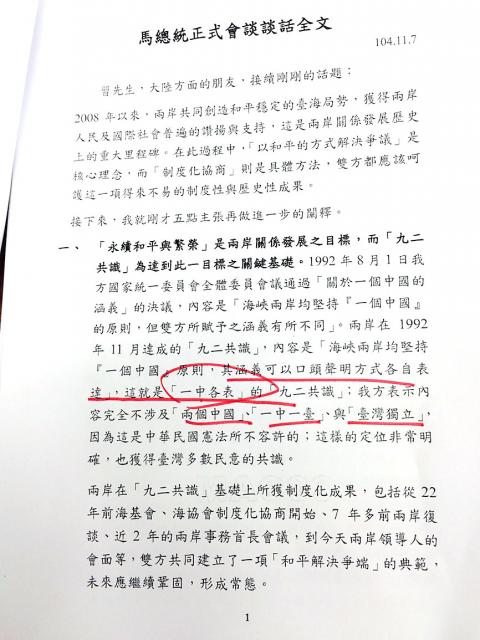The Mainland Affairs Council (MAC) yesterday released a transcript of President Ma Ying-jeou’s (馬英九) conversation with Chinese President Xi Jinping (習近平) at their closed-door meeting in Singapore on Saturday, as the landmark meeting continues to be marred by accusations of backroom dealings and the erosion of Taiwan’s sovereignty claims.
Ma delivered a 20-minute speech that addressed five areas: creating sustainable cross-strait peace and prosperity based on the so-called “1992 consensus”; reducing hostility and tackling disputes peacefully; expanding cross-strait exchanges to create win-win scenarios; establishing a cross-strait hotline for urgent issues; and reinvigorating the Zhonghua minzu (Chinese ethnic group, 中華民族) through cross-strait cooperation.
The “1992 consensus” refers to a tacit understanding reached during cross-strait talks in 1992 that both Taiwan and China acknowledge that there is “one China,” with each side having its own interpretation of what “China” means.

Photo: CNA
Former Mainland Affairs Council chairman Su Chi (蘇起) in 2006 admitted that he made up the term in 2000 while still in office, but it remains the Chinese Nationalist Party’s (KMT) cornerstone for dialogue with China.
“On Aug. 1, 1992, our [now-defunct] National Unification Council unanimously passed a resolution regarding the meaning of ‘one China’: both sides of the Taiwan Strait will adhere to the ‘one China’ principle, but will have different definitions of the term,” Ma said, according to the transcript.
Ma went on to say that “the ‘1992 consensus’ reached by the two sides in November 1992 stipulates that both sides of the Taiwan Strait will adhere to the ‘one China’ principle, but can verbally state their respective interpretations of what the term means.”
Taiwan’s interpretation does not include the terms “two Chinas,” “one China, one Taiwan” or “Taiwanese independence,” all of which are prohibited by the Republic of China (ROC) Constitution, Ma said.
“This position is rather unequivocal and is supported by the majority of Taiwanese,” Ma said.
The transcript was released after Ma defended his omission of the “different interpretations” component, which he often touts, when discussing the “1992 consensus” during his opening remarks at the meeting by saying it was mentioned during the closed-door session.
Ma said he brought up the Constitution twice with Xi, as well as one mention each of the ROC and “one China, different interpretations.”
Ma also mentioned the Constitution when speaking of the 1991 abolishment of the Temporary Provisions Effective During the Period of Communist Rebellion (動員戡亂時期臨時條款), putting an end to the government treating the People’s Republic of China as a rebellious entity.
That was followed by the implementation of the Act Governing Relations Between the People of the Taiwan Area and the Mainland Area (臺灣地區與大陸地區人民關係條例) in 1992, which institutionalized cross-strait negotiations, Ma said.
Regarding Chinese military deployments targeting Taiwan, Ma said that since the 23 cross-strait pacts signed by his administration were based on “peace” and were designed to help “maintain peace,” they could all be deemed peace treaties in a broad sense.
“I would like to explain to Mr Xi that recent media reports of [Chinese] military exercises at the Zhurihe training base and missiles [aimed at Taiwan] have given opposition parties leverage to criticize cross-strait ties,” Ma said.
“If possible, some well-intended actions by your side should help abate this sort of unnecessary criticism,” Ma added.
Turning to the growing predicaments faced by Taiwan in participating in international events, Ma said meaningful participation in the international community has always been the Taiwanese public’s greatest aspiration.
“The viable diplomatic platform promoted by our side over the past seven years has helped to create a virtuous cycle in cross-strait relations,” Ma said.
“However, this cycle has yet to reach its full potential, as evidenced by the UN recently refusing Taiwanese carrying [ROC] passports entry to its headquarters,” Ma added.
Impediments have also been encountered by Taiwanese specialists seeking to attend meetings held by non-governmental organizations and by the government in its attempts to join bilateral or multilateral economic and trade discussions.
“These circumstances have created a negative perception of Taiwanese, especially those considered to be in the social elite. Both sides should work to reduce hostility and confrontation, beginning from this area,” Ma said.
Ma concluded his speech by urging both sides of the Taiwan Strait to cooperate to create a brighter future for future generations.

The US government has signed defense cooperation agreements with Japan and the Philippines to boost the deterrence capabilities of countries in the first island chain, a report by the National Security Bureau (NSB) showed. The main countries on the first island chain include the two nations and Taiwan. The bureau is to present the report at a meeting of the legislature’s Foreign Affairs and National Defense Committee tomorrow. The US military has deployed Typhon missile systems to Japan’s Yamaguchi Prefecture and Zambales province in the Philippines during their joint military exercises. It has also installed NMESIS anti-ship systems in Japan’s Okinawa

‘WIN-WIN’: The Philippines, and central and eastern European countries are important potential drone cooperation partners, Minister of Foreign Affairs Lin Chia-lung said Minister of Foreign Affairs Lin Chia-lung (林佳龍) in an interview published yesterday confirmed that there are joint ventures between Taiwan and Poland in the drone industry. Lin made the remark in an exclusive interview with the Chinese-language Liberty Times (the Taipei Times’ sister paper). The government-backed Taiwan Excellence Drone International Business Opportunities Alliance and the Polish Chamber of Unmanned Systems on Wednesday last week signed a memorandum of understanding in Poland to develop a “non-China” supply chain for drones and work together on key technologies. Asked if Taiwan prioritized Poland among central and eastern European countries in drone collaboration, Lin

BACK TO WORK? Prosecutors said they are considering filing an appeal, while the Hsinchu City Government said it has applied for Ann Kao’s reinstatement as mayor The High Court yesterday found suspended Hsinchu mayor Ann Kao (高虹安) not guilty of embezzling assistant fees, reducing her sentence to six months in prison commutable to a fine from seven years and four months. The verdict acquitted Kao of the corruption charge, but found her guilty of causing a public official to commit document forgery. The High Prosecutors’ Office said it is reviewing the ruling and considering whether to file an appeal. The Taipei District Court in July last year sentenced Kao to seven years and four months in prison, along with a four-year deprivation of civil rights, for contravening the Anti-Corruption

NO CONFIDENCE MOTION? The premier said that being toppled by the legislature for defending the Constitution would be a democratic badge of honor for him Premier Cho Jung-tai (卓榮泰) yesterday announced that the Cabinet would not countersign the amendments to the local revenue-sharing law passed by the Legislative Yuan last month. Cho said the decision not to countersign the amendments to the Act Governing the Allocation of Government Revenues and Expenditures (財政收支劃分法) was made in accordance with the Constitution. “The decision aims to safeguard our Constitution,” he said. The Constitution stipulates the president shall, in accordance with law, promulgate laws and issue mandates with the countersignature of the head of the Executive Yuan, or with the countersignatures of both the head of the Executive Yuan and ministers or